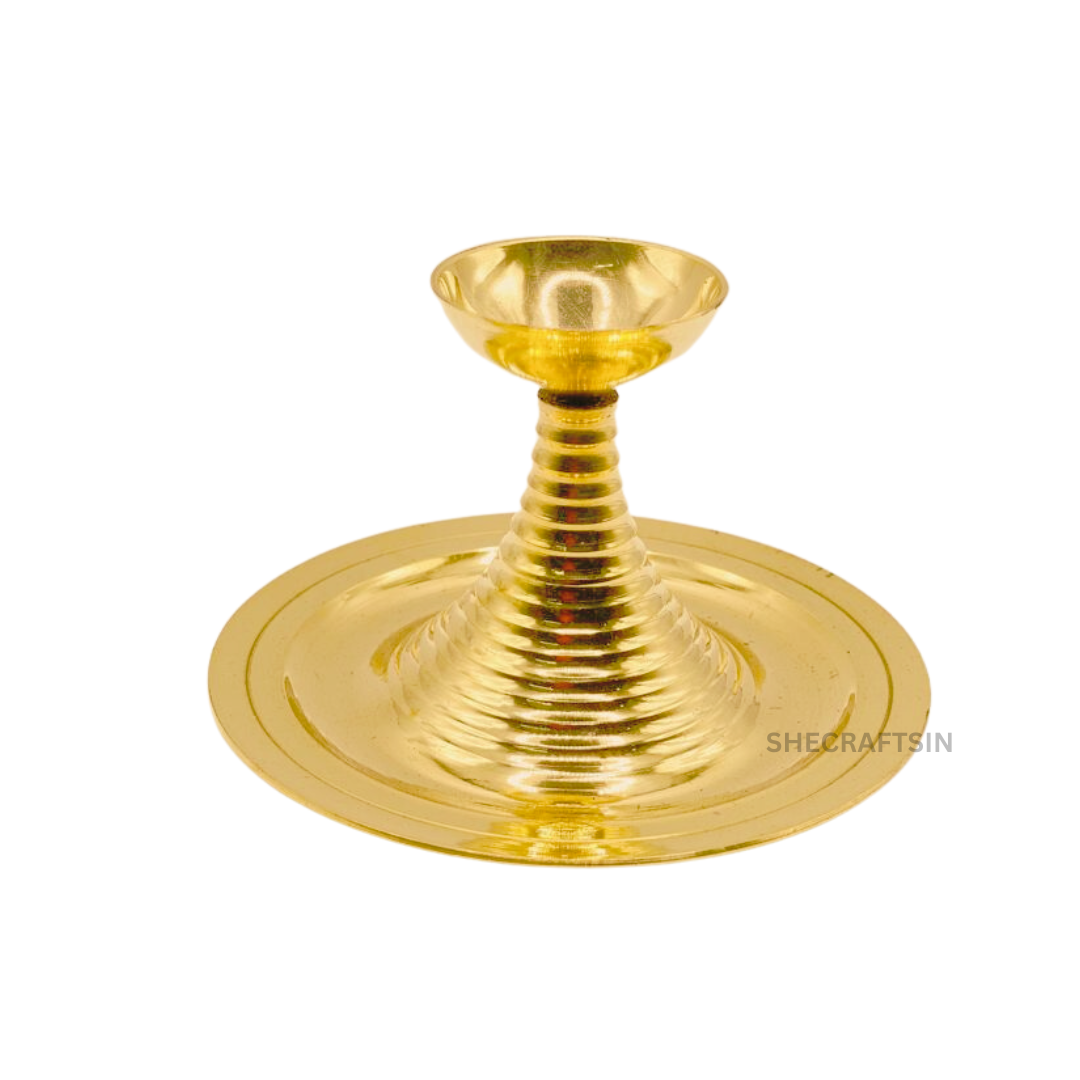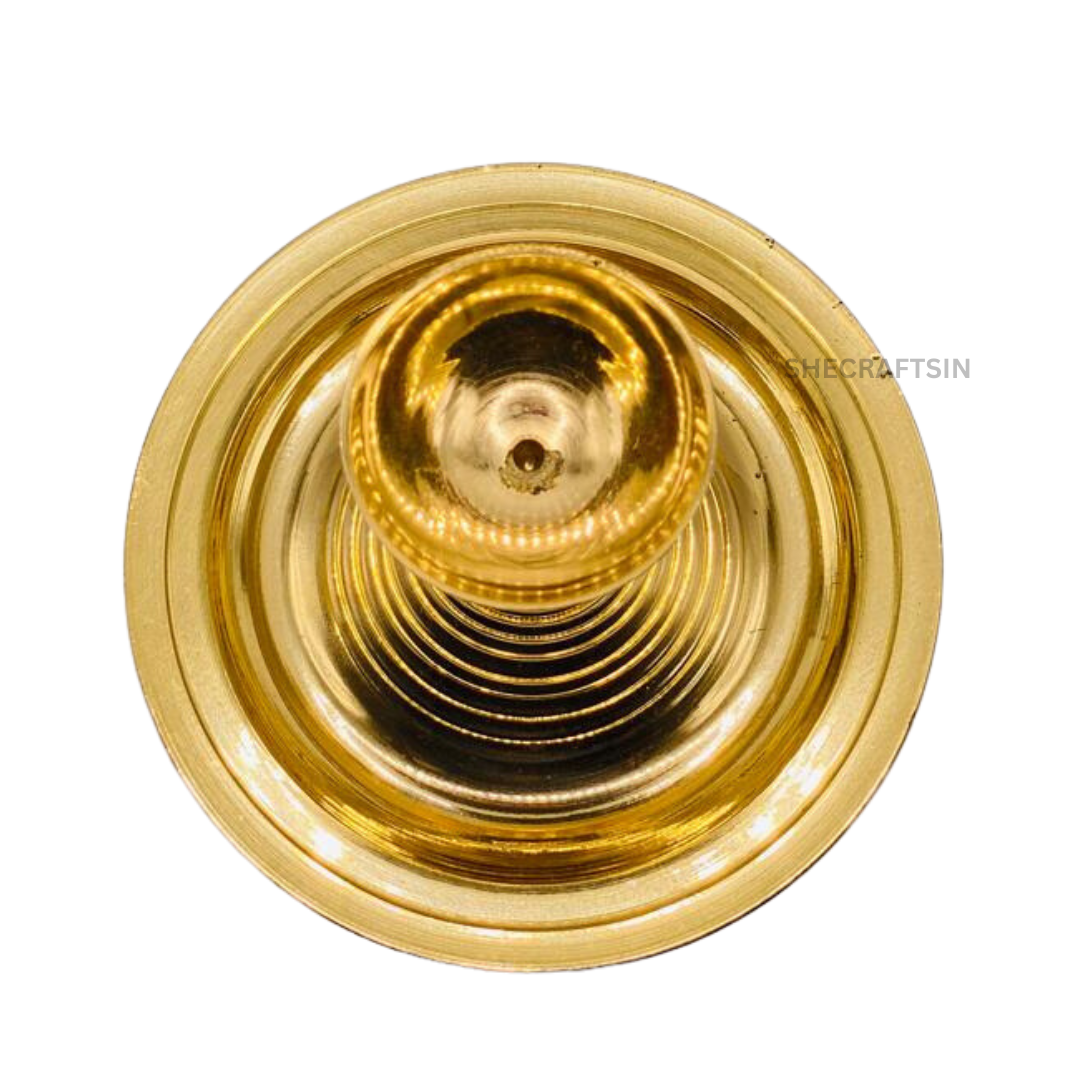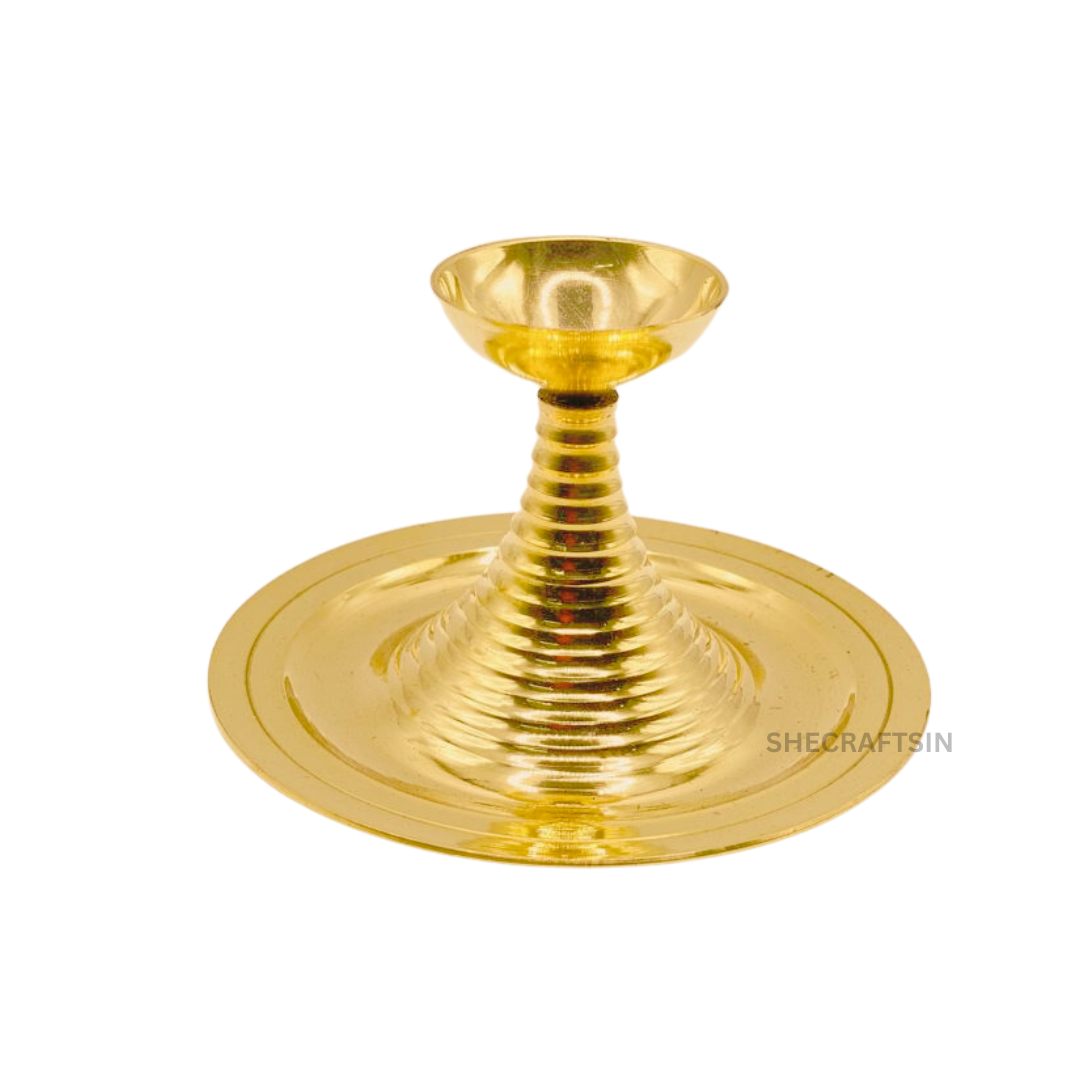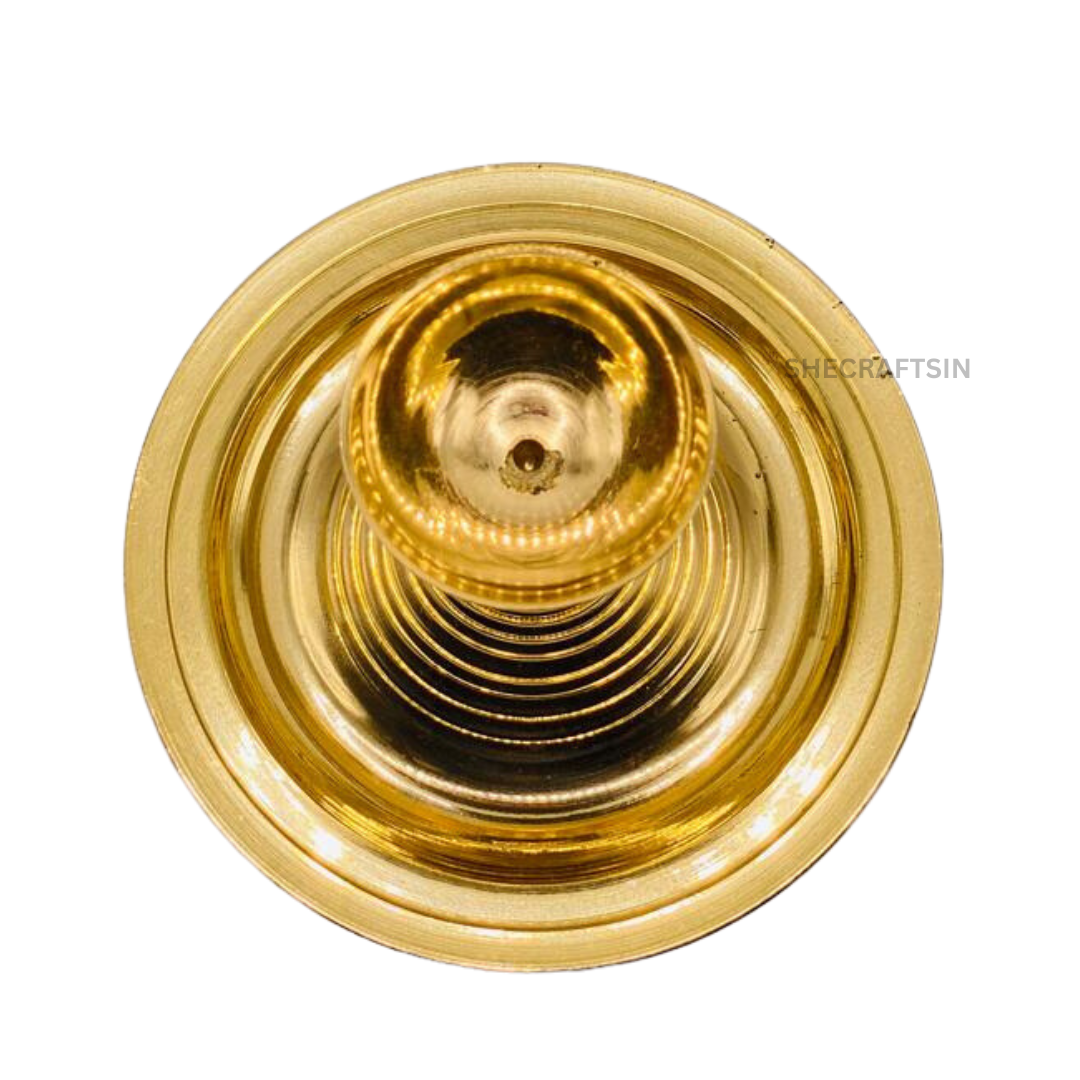She Crafts In
BRASS KARPOORATHATTU | CAMPHOR HOLDER | KARPOORA ARATHI | ARTI
BRASS KARPOORATHATTU | CAMPHOR HOLDER | KARPOORA ARATHI | ARTI
Couldn't load pickup availability
Karpurathattu, often referred to as a "Camphor Stand" or "Camphor Burner," is a traditional and ritualistic item used in Hindu religious ceremonies, particularly during Pooja (worship) and Aarti (ceremony of offering light to deities). It is designed to hold a small piece of camphor, which is ignited and used as a sacred source of light and fragrance during these rituals. Camphor is considered highly purifying and is believed to symbolize the burning away of impurities.
Karpurathattus come in various forms and materials, and the use of brass is quite common due to the metal's auspicious and traditional significance in Hindu rituals. The brass Karpurathattu, often ornate and beautifully crafted, can add an element of sacredness and aesthetics to the Pooja setup.
2. Brass in Religious and Cultural Contexts:
Brass is a widely used metal in the crafting of religious and cultural artifacts. It has been employed for centuries in the creation of various ritual objects, sculptures, and ornaments due to its unique properties:
-
Auspiciousness: Brass is often considered an auspicious metal in Hinduism. It is believed to be a symbol of purity and divinity, making it a preferred choice for religious and ceremonial items.
-
Durability: Brass is highly durable and resistant to corrosion, making it a practical choice for objects intended for long-term use.
-
Artistic Expression: Brass can be intricately molded and engraved, allowing artisans to create exquisite designs that reflect the culture and heritage of the region in which they are crafted.
-
Sound Resonance: In addition to its visual appeal, brass is also known for its resonant qualities. It is used to create bells, gongs, and musical instruments that produce melodious sounds, often used in religious ceremonies.
-
Sustainability: Brass is relatively easy to recycle and is considered a sustainable choice for crafting items due to its long-lasting properties.
3. The Craftsmanship and Aesthetics of Brass Karpurathattu:
Brass Karpurathattus are often crafted with meticulous attention to detail and aesthetics. The artistic expression varies, and these objects can range from simple and utilitarian to highly ornate and decorative. Some key elements and characteristics of brass Karpurathattus include:
-
Design: The design of a brass Karpurathattu typically features a base or platform that holds the camphor, a stand or handle, and often intricate patterns, engravings, or relief work. The design may vary, with some Karpurathattus having more traditional or classic motifs, while others may exhibit contemporary or regional influences.
-
Size: Brass Karpurathattus come in various sizes, from small and portable to larger and more elaborate pieces. The choice of size often depends on the specific use and personal preferences.
-
Intricacy: Many brass Karpurathattus showcase intricate patterns, which may include religious symbols, deities, or floral motifs. These details enhance the aesthetic appeal of the item and make it a focal point of the Pooja setup.
-
Finishing: Brass Karpurathattus may be polished to a high sheen, which gives them a lustrous and attractive appearance. The finishing may vary, with some preferring a more traditional and antique finish to give the item a vintage look.
-
Artisanal Craftsmanship: The creation of a brass Karpurathattu involves the skills of skilled artisans who specialize in working with metals. Their craftsmanship reflects the cultural and artistic heritage of the region where the item is made.
4. Ritual Use of Brass Karpurathattu:
The Brass Karpurathattu plays a central role in Hindu rituals, particularly during Pooja and Aarti. Here's how it is used in these ceremonies:
-
Placement: The Karpurathattu is placed on the Pooja altar or designated sacred space, usually in proximity to the deity's idol or image.
-
Camphor Preparation: A small piece of camphor is placed in the container of the Karpurathattu.
-
Ignition: The camphor is ignited using a separate source of flame, such as a diya (lamp) or aarti lamp.
-
Aarti Ceremony: The burning camphor is then used as a source of light in the aarti ceremony. The aarti involves waving the lit camphor in a circular motion in front of the deity to symbolize the offering of light and devotion.
-
Fragrance: In addition to providing light, the burning camphor emits a pleasant fragrance that is believed to purify the atmosphere and create a sacred ambiance.
-
Symbolism: Camphor is considered a symbol of purity and the burning away of impurities. The aarti ceremony is an act of showing reverence and seeking blessings from the divine.
The use of a Brass Karpurathattu adds a touch of elegance and tradition to the ritual, enhancing the overall spiritual experience. The object is not only functional but also a visual representation of the devotee's dedication and respect for the divine.
5. The Role of Brass Karpurathattu in Festivals and Special Occasions:
Brass Karpurathattus are particularly significant during Hindu festivals and special religious occasions. Some key events where these items are prominently featured include:
-
Diwali: During the festival of Diwali, which is celebrated with great fervor, Karpurathattus play a significant role in illuminating homes and temples. The lighting of camphor signifies the victory of light over darkness.
-
Temples and Shrines: In temples and shrines, Karpurathattus are used regularly for daily Pooja and aarti ceremonies. They are often on display as part of the sacred decor.
-
Weddings and Religious Ceremonies: Brass Karpurathattus are also used during weddings and various religious ceremonies as part of the rituals and blessings.
-
Pujas and Rituals: Devotees frequently use Karpurathattus during individual or family Poojas and rituals, such as Satyanarayan Puja, Ganesh Chaturthi, and more.
-
Gifting: Brass Karpurathattus are often given as thoughtful gifts during religious occasions, such as housewarming ceremonies and weddings.




